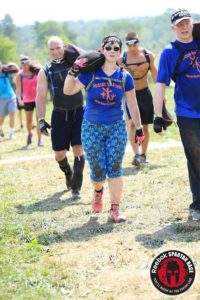Continuing my Spartan Race series, today I would like to chat a little bit about the difference in preparation between a Sprint, Super, and Beast. I’m going to break this down by preparation step so you can really see how my process changes depending on the Spartan distance I’m bracing for. Please note that I am not a coach, this is just my experience (which hopefully will be helpful to future Spartans).
Training Plan
The real difference between a Sprint, Super, and Beast is length of course which translates to amount of time an athlete will spend on the course. This means that your training plan is going to have to support you differently as you prepare for these races. For a Sprint, you’re probably looking at a 2-3 hour course time (unless you’re REALLY FAST or it’s a very long/tough Sprint). For a Super, you can be out there more like 4-6 hours. You can plan for anywhere between 5 and 10 hours on a Beast depending on your level of fitness and the length of the course.

Western Mass Super: 2016; Photo courtesy of Spartan Race
For all of the races, you’ll want to do a good combination of trail running and strength training in your training regime. There are some good training plans out there online you can dig up, or talk to a certified SGX coach who can help you craft one. Sprints, for me, don’t actually mean any difference in my regular training; Crossfit combined with a rigorous running schedule prepares me no problem. When I know I’m prepping for a Super, I make sure to mix in a couple 6-8 miles trail runs and some extra hill training. Beast prep involves long trail runs, lots of hill training, and lots of sled work (to get my quads and hams ready for the brutal ups/downs that a Spartan course entails). I also do fatigue or brick training when I prep for a Beast; back-to-back workouts with little rest between to get my body ready for the endurance aspect of the race.
Nutrition
No matter what race I’m on, I make sure to take in about 100 calories every hour, on the hour. I also take in a salt tab every hour (and one hour before I hit the course) particularly if it’s a very hot day. This means calculating approximately how long I’ll be on the course to prepare my nutrition packs. I am a slow, steady OCR racer and I can generally bank on my slowest miles being around 45 minutes on a Spartan course. As a result, I pack enough fuel for that time (since I want to make sure I have enough, and taking a little extra never hurt).
On a Sprint, I may or may not pack fuel. If I think I’ll be off the course in 2 hours or less, I’ll throw a Gu in my pocket but I won’t sweat it other than that. A Super requires a Camelbak so by then I’m in full nutrition prep mode. I pack everything in double-bagged ziplocks so my pack can be submerged without damage to the fuel and/or salt tablets. For a Beast, I basically pack a picnic. I will take “Frankenfuel” (Gu packs, Cliff Shot blocks, etc.), but I will also take real food like jerky, Rx bars, and trail mix. I don’t assume I will be off the mountain in less than 10 hours to make sure I have ample fuel, and I take anything I think might sound appetizing. IMPORTANTLY I don’t take any fuel that I haven’t previously trained with. The last thing I want on a Spartan course is a GI issue.
What’s in the Pack
As I mentioned, I don’t usually do a Sprint with a Camelbak, though I have made exceptions for exceptionally hot days, exceptionally long routes, or if I’m racing with a group who hasn’t done a Spartan before and might not be able to anticipate their own hydration/fuel needs. I do make sure I have a water-resistant watch and a pair of gloves (I use batting gloves; they really save my hands when I have to do burpees). For a Super, I pack all of my fuel, my sodium tablets, gloves, watch, full Camelbak (that I refill on course every chance I get because you NEVER KNOW), and travel sunscreen. Since I am generally on the course for a while, and since the course generally involves getting wet/sweaty/dirty, I want to make sure my skin doesn’t pay the price for being outside. This has been a marvelously effective way to avoid getting a dorky headband sunburn from the headband bib numbers you wear during a Spartan. On a Beast course, I pack all of this (more fuel, obviously), PLUS a few extra salt tabs (I have often been asked for extra by other racers, and I like to have one or two on hand beyond my own needs for this reason), and a spare long sleeved tech shirt if it’s likely to get breezy/cool down as the day wears on.
What I do After
Honestly, not much changes race to race. I eat more calories on a Beast day than on a  Sprint day, but I couldn’t tell you how much more because I make it a rule not to track my nutrition on race day. I take the same victory pictures. I drink the same amounts of victory beers. I smile with the same amazing feeling of accomplishment. I take the same awesome victory showers (…though I may wash my hair one or two times more on Beast day than on Sprint day). I wear my medal all day long (race day tradition). A Spartan is a Spartan and it’s an incredible thing to achieve no matter what distance you’re racing, so I stay proud any way I slice it.
Sprint day, but I couldn’t tell you how much more because I make it a rule not to track my nutrition on race day. I take the same victory pictures. I drink the same amounts of victory beers. I smile with the same amazing feeling of accomplishment. I take the same awesome victory showers (…though I may wash my hair one or two times more on Beast day than on Sprint day). I wear my medal all day long (race day tradition). A Spartan is a Spartan and it’s an incredible thing to achieve no matter what distance you’re racing, so I stay proud any way I slice it.
So, Spartans, anything I’m missing here?




 I’m generally good to go after an hour or two and some serious feeding. More than that and I start to push into areas where my body just doesn’t want to do ANYTHING for several hours. I can’t blame it; it’s not like running 20 miles is easy or anything.
I’m generally good to go after an hour or two and some serious feeding. More than that and I start to push into areas where my body just doesn’t want to do ANYTHING for several hours. I can’t blame it; it’s not like running 20 miles is easy or anything.

